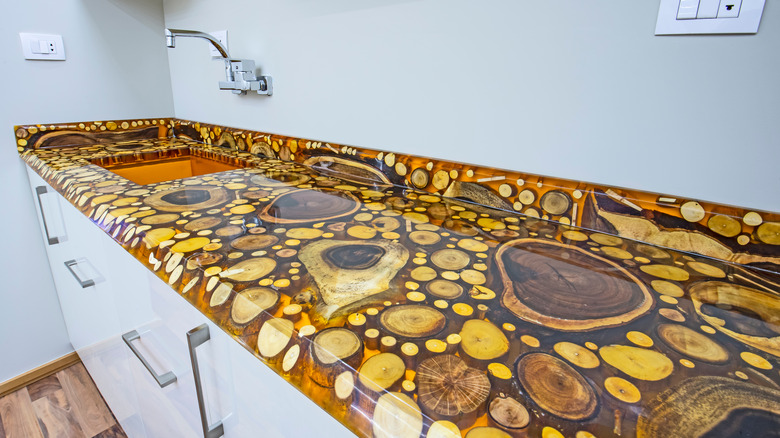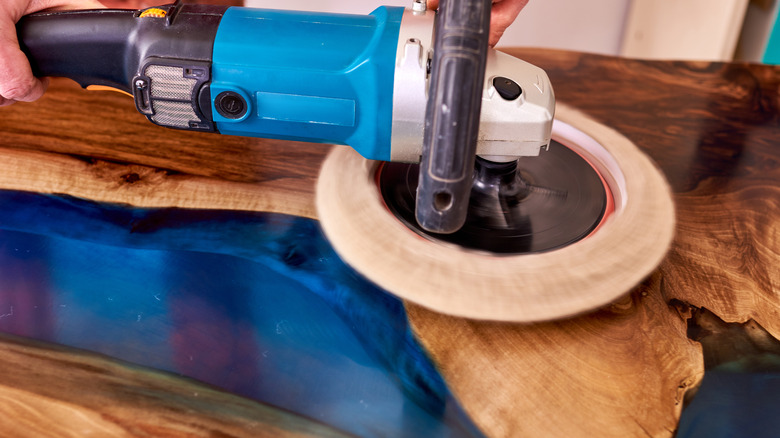The Hidden Downsides To Trendy Epoxy Countertops
In case you're thinking of refurbishing your kitchens and bathrooms, you might be on the hunt for trendy and attractive countertop options that won't force you to empty your pockets. While finding a counter that checks all these boxes might seem impossible, you'd be hard-pressed to ignore the glossy epoxy countertops dominating your social media feeds. Epoxy countertops look chic, and they're quite affordable. Just thinking about the dazzling DIY that'll turn your countertops into a unique home feature will make you giddy. However, before you go for it, don't forget to consider the crucial hidden downsides of epoxy countertops.
Epoxy is a popular countertop trend, but many, such as the Property Brothers, want you to avoid it at all costs due to a number of underlying issues. For starters, epoxy countertops might develop a yellow-ish tinge after a while if they're exposed to direct sunlight. Additionally, they have only mild heat resistance, they can't mimic the look of natural stone countertops, the finish might appear cheap if installed improperly, and epoxy is prone to peeling and cracking after some time. Moreover, installing epoxy countertops is not as easy as it seems. Although there's no dearth of resources online, you are bound to face challenges as a novice, especially if you aren't familiar with the world of DIY. Let's take a look at where epoxy countertops can fall short.
Epoxy countertops aren't DIY-friendly and have hidden costs
Admittedly, epoxy is one the best ways to update laminate countertops on a budget (without replacing them), but it isn't as cost-effective as it's marketed. To elaborate, you won't find epoxy, a mixture of resin and hardener, in a neat ready-made package in your local stores. The reason behind this is simple. Once the epoxy constituents are mixed, it starts curing within half an hour and it'll be difficult to spread it after that time. Simply put, you only have 30 minutes to spread the concoction to get your preferred design. If this isn't done right, you'll have to contend with an uneven surface or unsightly bubbles, forcing you to scrape off the epoxy and start all over again. Moreover, if you pour more than necessary, you'll have to deal with drips all over the floor.
Considering the time, effort, and patience involved, you might benefit from professional help instead of DIYing the installation, especially if you are spreading epoxy over an uneven or damaged surface. While contracting a professional will make customizations possible, the associated labor charges might throw your budget into disarray. In fact, Angi estimates you'll have to shell out between $50 and $150 per square feet — yes, labor is more expensive than material. Even if you're confident in your DIY abilities and opt for a dedicated epoxy kit to make your life easier, you'll have to spend a minimum of $100.
Other downsides to trendy epoxy countertops
Epoxy is a diva when it comes to maintenance. To elaborate, spills must be wiped immediately, including water, or you risk a permanent stain on your countertop. Additionally, you need to seal the counter every year or two using a polyurethane sealer to prolong its life. Plus, if you go the DIY route, taking precautions is necessary to maintain your health. The resin in epoxy should only be used in well-ventilated areas. It's advisable to wear a mask so as not to breathe the mix, as it may adversely affect your health over time.
Besides that, epoxy isn't heat-resistant, so you can't leave hot utensils on the counters without risking damaging the finish. And that's not all. They're incredibly sensitive to the sunlight. Therefore, exposing them to UV rays might damage the coating or discolor it, effectively undoing all your (or the professional's) hard work. Also, with prolonged use, the edges and the most used parts on the epoxy countertops start chipping off. Lastly, you can't use harsh chemicals to clean your epoxy countertops or they'll lose their color and glow. These are all restrictions you should keep in mind before embarking on your epoxy countertop journey.

